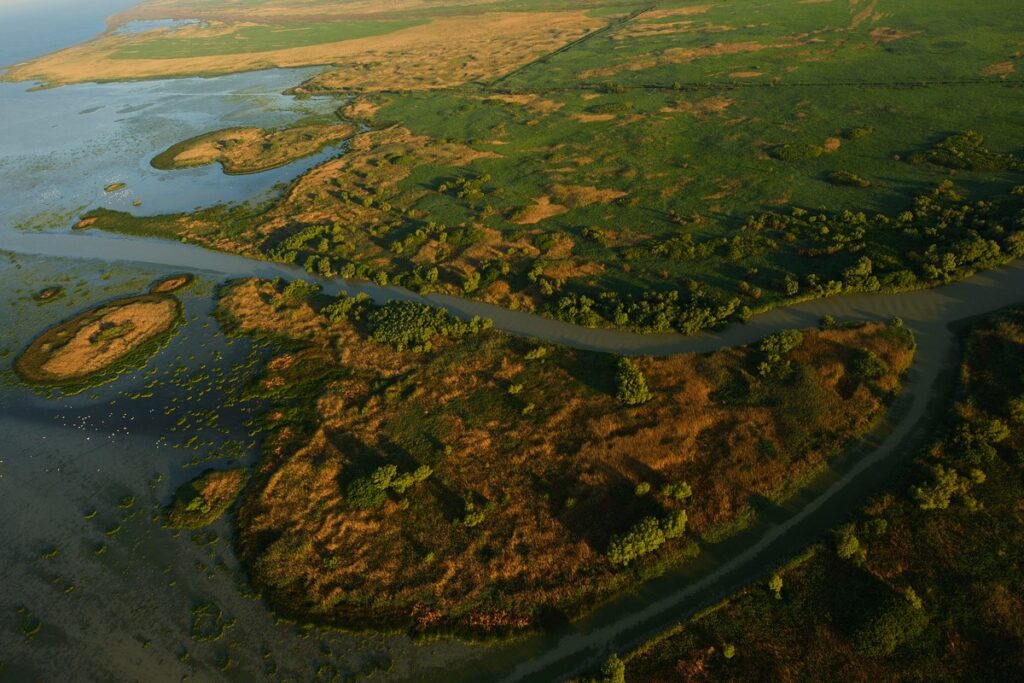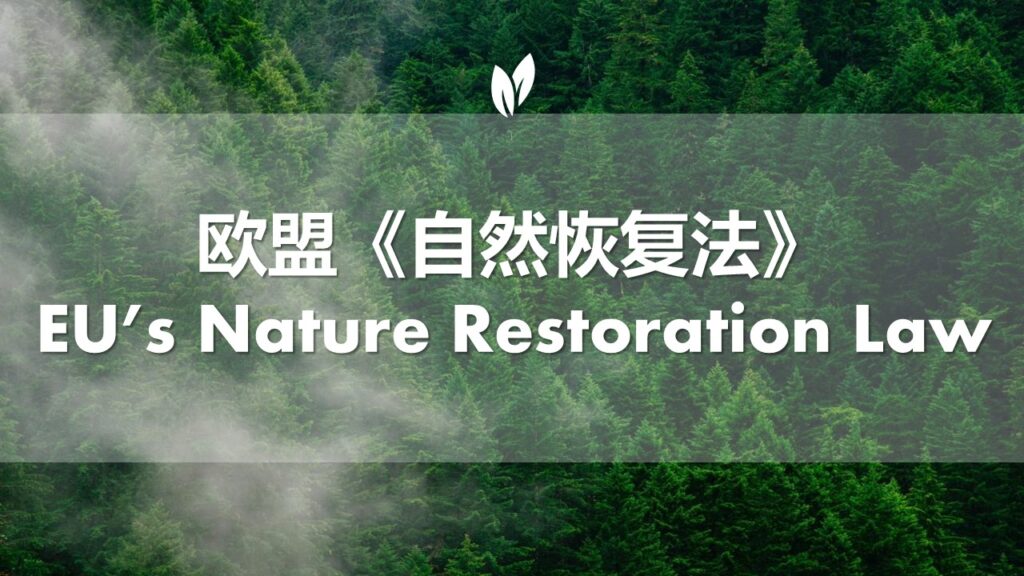减缓和适应气候变化的支柱
A Pillar for Climate Mitigation and Adaptation
欧盟的《自然恢复法》是《欧洲绿色协议》的核心组成部分,是一项旨在扭转欧洲生态系统退化趋势的有力的立法工作。它旨在重建生物多样性和确保生态系统服务,这对欧盟的气候减缓和适应目标至关重要。这项法律是使环境恢复与更广泛的气候战略保持一致的重要工具。
The EU’s Nature Restoration Law, introduced as a central component of the European Green Deal, is an ambitious legislative effort aimed at reversing the degradation of Europe’s ecosystems. It seeks to re-establish biodiversity and secure ecosystem services, which are crucial for the EU’s climate mitigation and adaptation goals. This law is an essential tool in aligning environmental restoration with broader climate strategies.
《自然恢复法》概述
《自然恢复法》是一项开创性提案,旨在解决欧洲自然环境的危急状况。该法律为恢复欧洲大陆退化的生态系统设定了具有法律约束力的目标。其目标是到 2030 年恢复欧盟 20% 的陆地和海洋区域,最终到2050年将恢复活动扩展到所有需要恢复的生态系统。
该法重点关注各种生态系统,包括森林、湿地、草原和海洋栖息地,它们不仅对生物多样性至关重要,而且对气候调节也至关重要。欧盟委员会已经认识到,这些生态系统的退化会加剧气候变化,导致碳排放增加和自然碳汇减少。通过恢复这些地区,欧盟旨在加强抵御气候变化的自然防御能力。
Overview of the Nature Restoration Law
The Nature Restoration Law is a groundbreaking proposal designed to address the critical state of Europe’s natural environments. The legislation sets legally binding targets for the restoration of degraded ecosystems across the continent. It aims to restore 20% of the EU’s land and sea areas by 2030, ultimately extending restoration activities to all ecosystems in need by 2050.
The law focuses on various ecosystems, including forests, wetlands, grasslands, and marine habitats, which are essential not only for biodiversity but also for climate regulation. The European Commission has recognized that the degradation of these ecosystems exacerbates climate change, leading to increased carbon emissions and reduced natural carbon sinks. By restoring these areas, the EU aims to bolster natural defences against climate change.
减缓和适应气候变化的目标
《自然恢复法》的主要目标之一是显著促进欧盟的气候缓解和适应战略。在这些工作中,生态系统的恢复发挥着双重作用:
- 气候减缓:健康的生态系统可作为碳汇,吸收大气中的二氧化碳,帮助稳定全球气温。森林、湿地和泥炭地在固碳方面尤为有效。《自然恢复法》规定在退化的土地上重新造林并恢复湿地,旨在提高它们吸收碳的能力。这对于实现欧盟到 2030 年将温室气体排放量比1990年至少减少 55% 的目标至关重要。
- 气候适应:恢复生态系统可增强抵御气候变化影响的能力。例如,湿地可以通过吸收多余的水分来减轻洪水的影响,而恢复的森林和草地可以减少土壤侵蚀并防止荒漠化。该法律对这些自然缓冲区的恢复,有助于保护人类和基础设施免受气候变化引发的日益频繁和严重的极端天气事件的影响。
Objectives for Climate Mitigation and Adaptation
One of the primary objectives of the Nature Restoration Law is to contribute significantly to the EU’s climate mitigation and adaptation strategies. Restoration of ecosystems plays a dual role in these efforts:
- Climate Mitigation: Healthy ecosystems act as carbon sinks, absorbing carbon dioxide from the atmosphere and helping to stabilize global temperatures. Forests, wetlands, and peatlands are particularly effective at sequestering carbon. The Nature Restoration Law mandates the reforestation of degraded lands and the restoration of wetlands, aiming to enhance their capacity to absorb carbon. This is critical for meeting the EU’s goal of reducing greenhouse gas emissions by at least 55% by 2030 compared to 1990 levels.
- Climate Adaptation: Restored ecosystems increase resilience against the impacts of climate change. Wetlands, for example, can mitigate the effects of flooding by absorbing excess water, while restored forests and grasslands can reduce soil erosion and prevent desertification. The law’s focus on restoring these natural buffers helps to protect human populations and infrastructure from extreme weather events, which are becoming more frequent and severe due to climate change.
自然恢复的成功案例
欧洲各地实施的自然恢复举措已经取得了积极的成果,显示了在新法律框架下扩大这些努力的潜力,其中两个显著的例子是多瑙河三角洲的再野化和芬兰湿地的恢复。
- 多瑙河三角洲再野化:多瑙河三角洲是欧洲生物多样性最丰富的地区之一,为重建自然洪泛动态和生物多样性,多瑙河三角洲开展了广泛的恢复工作。“再野化欧洲”领导了重新引入本地物种、恢复自然水流以及清除破坏生态系统的障碍物等举措。因此,三角洲现在更具备碳储存、支持野生动物和提供洪水防护等生态系统服务的能力。
- 芬兰的湿地恢复:在芬兰,恢复泥炭地一直是一项重点工作,这些泥炭地以前曾因林业和农业而排水不畅。这些工作包括堵塞排水沟、为干涸地区重新引入水源以及促进本地植被的生长。恢复后的泥炭地现在已成为重要的碳汇,吸收大气中的二氧化碳,同时还支持生物多样性和改善水质。
Success Stories in Nature Restoration
The implementation of nature restoration initiatives across Europe has already yielded positive results, demonstrating the potential for scaling up these efforts under the new law. Two notable examples include the rewilding of the Danube Delta and the restoration of wetlands in Finland.
- Danube Delta Rewilding: The Danube Delta, one of Europe’s most biodiverse regions, has seen extensive restoration efforts aimed at re-establishing natural floodplain dynamics and biodiversity. Rewilding Europe has led initiatives to reintroduce native species, restore natural water flows, and remove barriers that disrupted the ecosystem. As a result, the delta is now better equipped to store carbon, support wildlife, and provide ecosystem services such as flood protection.
- Wetland Restoration in Finland: In Finland, the restoration of peatlands, which were previously drained for forestry and agriculture, has been a key focus. These efforts have involved blocking drainage ditches, reintroducing water to dried areas, and promoting the growth of native vegetation. Restored peatlands are now acting as significant carbon sinks, absorbing carbon dioxide from the atmosphere while also supporting biodiversity and improving water quality.

多瑙河三角洲 – 来源:Rewilding Europe
Danube Delta – Source: Rewilding Europe
与更广泛的气候政策的整合
《自然恢复法》与其他欧盟气候倡议,如2030 年生物多样性战略和欧盟2050实现气候中和的总体目标相辅相成。通过法律强制实施生态系统恢复,确保自然解决方案再欧盟的气候政策中占据重要地位。
2030 年生物多样性战略:该战略概述了一项在整个欧洲遏制生物多样性丧失和恢复生态系统的全面计划,包括到2030年保护欧盟30%的陆地和海洋区域,以及通过支持生物多样性的实践恢复至少10%的农业用地等目标。《自然恢复法》以该战略为基础,确保恢复工作具有法律约束力,并在所有成员国系统地实施。
2050年气候中和目标:欧盟实现2050年气候中和的承诺,依赖于自然解决方案成果融入气候政策中。根据《自然恢复法》恢复生态系统对于固碳和减排至关重要,而这两点对于实现温室气体净零排放至关重要。
Integration with Broader Climate Policies
The Nature Restoration Law complements other EU climate initiatives, including the Biodiversity Strategy for 2030 and the EU’s overarching climate neutrality target by 2050. By legally mandating ecosystem restoration, the law ensures that nature-based solutions are integral to the EU’s climate policies.
Biodiversity Strategy for 2030: This strategy outlines a comprehensive plan to halt biodiversity loss and restore ecosystems across Europe. It includes targets such as protecting 30% of the EU’s land and sea areas by 2030 and restoring at least 10% of agricultural land through practices that support biodiversity. The Nature Restoration Law builds on this strategy by ensuring that restoration efforts are legally binding and systematically implemented across all member states.
Climate Neutrality by 2050: The EU’s commitment to achieving climate neutrality by 2050 hinges on the successful integration of nature-based solutions into climate policies. The restoration of ecosystems under the Nature Restoration Law is essential for sequestering carbon and mitigating emissions, both of which are critical for reaching net-zero greenhouse gas emissions.
面临的挑战
尽管《自然恢复法》是向前迈出的关键一步,但其成功与否将取决于能否克服若干挑战:
- 资金和资源:实施大规模恢复项目需要大量的财政资源和专业技术知识。欧盟已承诺为生物多样性调动公共和私人资金,但确保所有恢复活动的资金充足仍是一项挑战。
- 各成员国之间的协调:生态系统恢复通常跨越多个地区和国家,因此需要欧盟成员国之间进行强有力的协调与合作。《自然恢复法》的成功将取决于各成员国是否有能力使其国家政策与欧盟的总体目标保持一致,并就跨境恢复项目开展合作。
- 监测和执行:确保实现恢复目标需要强有力的监测系统和执行机制。欧盟需要制定明确的基准并定期评估进展情况,以确保各成员国按计划履行其恢复承诺。
Challenges
While the Nature Restoration Law is a critical step forward, its success will depend on overcoming several challenges:
- Funding and Resources: Implementing large-scale restoration projects requires substantial financial resources and technical expertise. The EU has committed to mobilizing public and private finance for biodiversity, but ensuring adequate funding for all restoration activities remains a challenge.
- Coordination Across Member States: Ecosystem restoration often spans multiple regions and countries, necessitating strong coordination and cooperation among EU member states. The success of the Nature Restoration Law will depend on the ability of member states to align their national policies with EU-wide objectives and to collaborate on cross-border restoration projects.
- Monitoring and Enforcement: Ensuring that restoration targets are met will require robust monitoring systems and enforcement mechanisms. The EU will need to establish clear benchmarks and regularly assess progress to ensure that member states are on track to meet their restoration commitments.

注:图为Natura 2000的标志。Natura 2000是欧盟为保护和管理自然资源而建立的一个全球最大的生态网络,这个网络覆盖了欧盟成员国的广泛区域,旨在维护欧洲最具重要性的物种及栖息地。根据《自然恢复法》,尤其是在2030年之前,欧盟国家应优先考虑恢复Natura 2000区域。
Note: Logo of Natura 2000. Natura 2000 is the world largest network of protected areas, covering a wide area of the EU Member States. It’s aimed to protect Europe’s most valuable and threatened species and habitats. According to the Nature Restoration Law, EU countries should give priority to restoring Natura 2000 areas until 2030.
各方利益相关者对未来的展望
《自然恢复法》的成功在很大程度上依赖于众多利益相关者的积极参与和贡献,包括研究机构、非政府组织、私营部门和地方社区。这些伙伴带来了丰富的专业知识、资源和创新解决方案,对法律的成功实施至关重要。
- 研究机构:通过提供前沿科学数据和进行影响评估,研究机构帮助制定恢复战略,并确保其基于最佳的现有证据。他们的工作还支持恢复项目的持续监测和评估,这对于根据需要调整战略至关重要。
- 非政府组织(NGO):NGO在倡导自然恢复、提高公众意识和动员基层支持方面发挥着重要作用。它们还常常充当地方社区与政策制定者之间的中间人,确保恢复工作具有包容性并考虑到所有利益相关者的需求。
- 私营部门:企业可以通过将自然解决方案融入其运营,并投资于恢复项目来做出贡献。私营部门的参与对于扩大恢复工作规模并确保其在财务上的长期可持续性至关重要。
- 地方社区:地方社区的参与对于恢复项目的成功至关重要,因为它们通常是生态系统退化的最直接受害者,并且从恢复工作中受益最多。通过让社区参与到恢复活动的规划和执行中,确保这些工作具有文化适应性和社会公平性。
And Future Prospects by All Stakeholders
The success of the Nature Restoration Law heavily depends on the active participation and contributions of many stakeholders, which include research institutions, non-governmental organizations, private sector entities, and local communities. These partners bring a wealth of expertise, resources, and innovative solutions to the table, which are essential for the law’s successful implementation.
- Research Institutions: By providing cutting-edge scientific data and conducting impact assessments, research institutions help to inform restoration strategies and ensure that they are based on the best available evidence. Their work also supports the continuous monitoring and evaluation of restoration projects, which is critical for adapting strategies as needed.
- Non-Governmental Organizations (NGOs): NGOs play a vital role in advocating for nature restoration, raising public awareness, and mobilizing grassroots support. They also often act as intermediaries between local communities and policymakers, ensuring that restoration efforts are inclusive and consider the needs of all stakeholders.
- Private Sector: Companies and businesses can contribute by integrating nature-based solutions into their operations and by investing in restoration projects. The private sector’s involvement is crucial for scaling up restoration efforts and ensuring that they are financially sustainable in the long term.
- Local Communities: The engagement of local communities is essential for the success of restoration projects, as they are often the most directly affected by ecosystem degradation and stand to benefit the most from restoration efforts. By involving communities in the planning and execution of restoration activities, it can be ensured that these efforts are culturally appropriate and socially equitable.
与 CNEUCN 及其合作伙伴的关系
通过促进合作和知识共享,仲欧脱碳科技(CNEUCN)可以为符合最新科研成果和最佳实践的恢复项目做出贡献。CNEUCN的网络还可以在监测恢复工作的进展方面发挥关键作用,提供宝贵的反馈意见,帮助完善和提高《自然恢复法》的有效性。
《自然恢复法》与 CNEUCN 之间的关系是共生的,《自然恢复法》提供立法框架和目标,而 CNEUCN 则促进实现这些目标所需的实际执行和跨境合作。这种协调对于克服大规模生态系统恢复的复杂性以及确保以一致、高效的方式实现欧盟的气候和生物多样性目标至关重要。
Relationship with CNEUCN and its Partners
By fostering collaboration and knowledge sharing, China Europe Carbon Neutral (CNEUCN) can contribute to restoration projects which are aligned with the latest scientific research and best practices. Its network also can play a key role in monitoring the progress of restoration efforts, providing valuable feedback to help refine and enhance the effectiveness of the Nature Restoration Law.
The relationship between the Nature Restoration Law and CNEUCN is symbiotic, with the law providing the legislative framework and targets, while CNEUCN facilitates the practical implementation and cross-border cooperation necessary to achieve these goals. This coordination is vital for overcoming the complexities of large-scale ecosystem restoration and ensuring that the EU’s climate and biodiversity objectives are met in a cohesive and efficient manner.
结论
《自然恢复法》是欧盟环境和气候政策的关键。通过从法律上强制要求恢复生态系统,欧盟在应对生物多样性丧失和气候变化双重危机方面迈出了大胆的一步。该法对气候减缓和适应的关注,凸显了大自然在实现欧盟长期气候目标中的关键作用。
CNEUCN 合作伙伴的共同努力不仅加强了《自然恢复法》的实施,还为“欧盟绿色协议”的更广泛目标做出了贡献,有助于为所有人建设一个具有复原力和可持续发展的未来。
通过持续的承诺与合作,包括 CNEUCN 及其合作伙伴的积极参与,《自然恢复法》有可能为欧盟的生态系统及其人民保障一个可持续和有韧性的未来。
Conclusion
The Nature Restoration Law represents a pivotal moment in the EU’s approach to environmental and climate policy. By legally mandating the restoration of ecosystems, the EU is taking a bold step towards addressing the twin crises of biodiversity loss and climate change. The law’s focus on climate mitigation and adaptation highlights the critical role of nature in achieving the EU’s long-term climate goals.
The collaborative efforts of CNEUCN partners not only enhance the implementation of the Nature Restoration Law but also contribute to the broader goals of the EU’s Green Deal, helping to build a resilient and sustainable future for all.
With continued commitment and collaboration, including the active engagement of CNEUCN and its partners, the Nature Restoration Law has the potential to secure a sustainable and resilient future for European Union’s ecosystems and its people.
